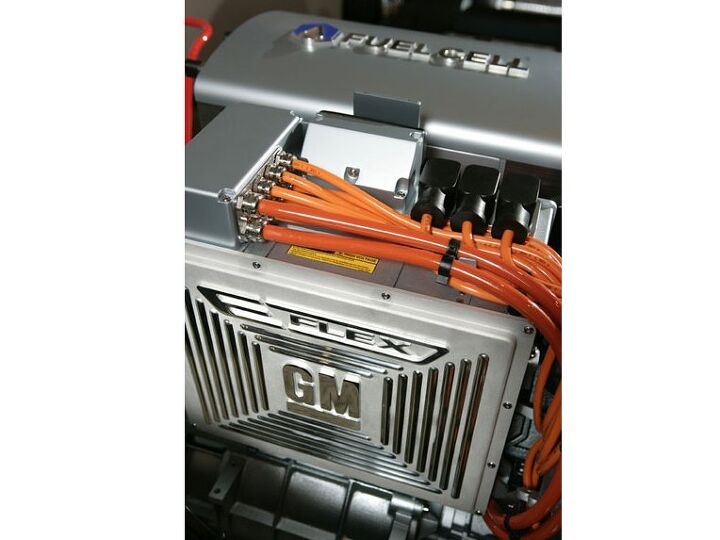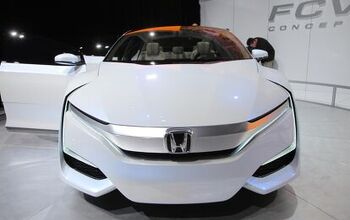Department Of Energy: Hydrogen Still The Future
Same as it ever was. Green Car Congress covers a DOE report (pdf) to the U.S. Congress on its $1.2b Hydrogen fuel cell development caucus, and the conclusion is clear: keep waiting. The DOE had harbored a shockingly naive hope that OEMs would be able to field 100k fuel cell vehicles by 2010, but the new report seems pretty clear on the chances of that happening. According to the report, “a 2008 independent study estimated that the high-volume manufacturing cost of automotive fuel cell systems (using current technology and assuming 500,000 units per year) would be $73/kW, which equates to almost $6000 for an 80-kW system. This current technology would be more than twice as expensive as internal combustion engine systems. And, based on the highest demonstrated durability to date, fuel cell systems would have a lifespan of approximately 1900 hours, which equates to about 57,000 miles and is still substantially lower than today’s estimated vehicular lifespan of 150,000 miles.” Sound familiar?
But, don’t worry. That $1.2b went to good use, “improving understanding of size range and spatial distribution of nano-scale water channels in Nafion membranes; . . . Developing and demonstrating a novel cryo-compressed tank concept” for which “system cost remains an issue”; and countless other “breakthroughs” which somehow don’t make hydrogen any less of a pipedream than it was two decades ago. The best part? “While fuel cell technology development is currently on track to meet the Program’s 2015 technology-readiness targets, it is too early to determine whether industry can achieve the 2020 vehicle deployment goal of 2.5 million hydrogen-fueled vehicles identified in [Energy Policy Act] section 811(a). However, analyses conducted by Oak Ridge National Laboratory indicate that such a deployment scenario would not be achieved without substantial supportive policies and incentives.” Fantastic. But hey, the DOE wants your feedback on their hydrogen dreams. Check out their request for information (RFI) here.
More by Edward Niedermeyer
Latest Car Reviews
Read moreLatest Product Reviews
Read moreRecent Comments
- Rochester I'd rather have a slow-as-mud Plymouth Prowler than this thing. At least the Prowler looked cool.
- Kcflyer Don't understand the appeal of this engine combo at all.
- Dave M. This and the HHR were GM's "retro" failures. Not sure what they were smoking....
- Kcflyer Sorry to see it go. The interior design and color options in particular are rare in the industry
- Wolfwagen Here is my stable. not great not bad I try to do as much as possible. I work for an Aftermarket automotive parts company so I can get most parts at a discount.i try to do as much of my own work as possible. My wife hates that I spend time and money fixing the vehicles but she doesn't want car payments either so...2019 VW Atlas 50K (wife's) Only issues so far were Brakes and normal maintenance.A Bad Cat Converter which was covered and a replacement of the rear bank head gasket which was a manufacturing defect due to improper torquing at the factory. All under warranty2003 Saab 9-5 Arc Wagon (my DD) 116 K picked up used last year. Replaced Struts, brakes, hatch struts, motor mounts, D/S swaybar link, Timing belt, water pump and thermostat Power steering pump Fuel pump, Both Front window regular rollers, Heater core and cabin air filter. Oil and transmission changes. Love the car but Saab/GM packaging is a nightmare.2005 Cadillac Deville (former DD now Son # 1 DD) picked up used 5 years ago with only 47K now 83K Plugs, coils, P/s pump, Water pump, hoses, P/S lines (mechanic job) evap valve, brakes, Front brake calipers and rear brake calipers. Currently has oil pan gasket leak - looking to have a mechanic do that2009 Mini Cooper (Daughters dd)picked up 2 years ago 67K Brakes and thermostat house to clear check engine light2001 Mazda Tribue (Son#2 dd) 106K picked last summer after he severely damaged a 2004 Hyundai accent. Oil changes


































Comments
Join the conversation
Hydrogen, even liquid hydrogen, is so light that any given volume of it carries very little energy. One liter of liquid hydrogen contains 71 grams of hydrogen. One liter of gasoline contains 118 grams of hydrogen, and one liter of diesel, 130 grams. Of course liquid hydrogen costs lots of energy to make, is difficult to store (it will leak out of any container in a matter of days), and is 423 degrees F below zero, so be very careful when handling it. Compressed hydrogen is less dense than liquid, and kaboom.
Seems as if the DOE wants to curtail their spending on the hydrogen economy. Even Ballard Power in Canada saw fit to exit the fuelcells-for-cars business some time ago. The announcement came as they spun off their test cell business. Confidence couldn't have been high at the time as it needed the key researchers to form the management team of this new entity. Later on this team secured all the related equipment in a buyout package. At least that was my understanding. Though hydrogen may be the the first to go here, I can see when American Leyland eventually goes under that the DOE will have even more reason to terminate other related powertrain programs it has scattered among the various National Labs. It almost seems that research in North America is wholly in the public sector, with the costs socialised wherever possible and when applicable the profits privatised. It makes me feel that the government should form an engineering corp just like we have the police, teachers, mail delivery and other public services. That it is a given that you become a government worker as an entitlement when you leave college/university and only in rare cases do you move out into the employ of capitalised companies. T2